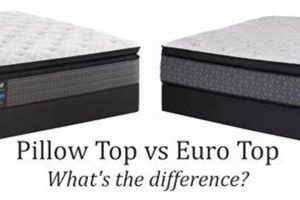A standard-sized bed, often marketed under two different names, measures approximately 54 inches wide by 75 inches long. This size offers more sleeping space than a twin, accommodating individuals who require more room or those who sleep with a pet. Its dimensions provide a balance between space efficiency and comfort, making it a popular choice for guest rooms and smaller bedrooms.
The adoption of this bed size has historical roots in the need for a sleeping surface larger than a single bed but smaller than a queen or king. Its benefits lie in its ability to comfortably accommodate one adult while not overwhelming a room. This option is a practical and economical choice for individuals transitioning from a smaller bed or furnishing a space with limited square footage. The widespread availability of bedding and frames further contributes to its enduring popularity.
The subsequent sections will delve into a comparative analysis, exploring key factors such as suitability for different sleeping arrangements, typical pricing considerations, and the range of available bedding options and accessories. This comprehensive overview aims to provide potential buyers with the information necessary to make an informed decision based on individual needs and preferences.
Considerations for a Standard-Sized Bed Selection
The selection of the appropriate sleeping surface requires careful evaluation. Several factors contribute to a sound decision-making process, ensuring optimal comfort and long-term satisfaction.
Tip 1: Assess Room Dimensions: Prior to purchase, accurately measure the intended room. Ensure sufficient clearance around the bed to allow for movement and placement of additional furniture. Consider door swing and walk-through space.
Tip 2: Evaluate Occupancy: Determine the primary use of the bed. For single occupancy, this size may offer ample space. For couples, consider the dimensions in relation to individual sleeping preferences and potential for motion disturbance.
Tip 3: Examine Body Size and Sleep Style: Individuals with larger frames or those who prefer to stretch out may find this option restrictive. Consider sleeping posture side sleepers may require more width than back sleepers.
Tip 4: Compare Mattress Materials: Explore available mattress materials, including innerspring, memory foam, and hybrid options. Each material offers distinct support, temperature regulation, and motion isolation characteristics. Research material durability and longevity.
Tip 5: Review Budget Constraints: Establish a realistic budget encompassing the mattress, frame, and bedding. Prices can vary significantly based on material quality, brand reputation, and included features. Factor in potential long-term replacement costs.
Tip 6: Check Bedding Availability: Ensure that appropriately sized sheets, comforters, and other bedding accessories are readily available and affordable. Non-standard sizes may necessitate custom orders, increasing expenses.
Tip 7: Analyze Frame Options: Evaluate available frame styles, considering factors such as support, aesthetics, and storage options. Ensure the chosen frame provides adequate support for the selected mattress type.
Careful consideration of these factors facilitates a well-informed decision, maximizing the potential for a comfortable and restful sleep experience. Prioritizing individual needs and conducting thorough research is paramount.
The subsequent sections will address alternative bed sizes and their suitability for various needs, further broadening the scope of the decision-making process.
1. Interchangeable Nomenclature
The interchangeable use of “full” and “double” to describe a specific bed size is a critical aspect of consumer understanding within the bedding market. This nomenclature impacts search behavior, purchase expectations, and overall market transparency. This exploration elucidates facets of this interchangeable use, promoting clarity for prospective buyers.
- Historical Context and Evolution of Terminology
The origin of the terms “full” and “double” likely stems from early bed sizing conventions relative to single or twin beds. “Double” implied a bed twice the width of a twin. Over time, “full” emerged as an equivalent, potentially to modernize the term or differentiate marketing strategies. Understanding this evolution clarifies why both terms persist.
- Regional Variations in Usage
While largely interchangeable, regional preferences may exist. Some geographic areas might favor one term over the other due to historical marketing campaigns or regional manufacturers’ conventions. Examining regional usage patterns is relevant for targeted marketing and understanding localized consumer habits.
- Impact on Online Searches and E-Commerce
Consumers searching online may use either term. E-commerce platforms must optimize search algorithms to recognize both terms as synonymous, ensuring comprehensive results. Retailers should use both “full” and “double” in product descriptions to maximize visibility and capture all potential customer searches. This impacts website SEO and product discoverability.
- Potential for Consumer Confusion and Misinterpretation
Despite their equivalence, the presence of two terms can induce confusion, particularly for first-time buyers. Consumers may incorrectly assume they denote different sizes or characteristics. Retailers have a responsibility to clarify this synonymy, either through explicit messaging or informative guides. This reduces the risk of returns and enhances customer satisfaction.
The interchangeable nature of “full” and “double” highlights the importance of standardized dimensions and clear communication in the bedding industry. While the terms are functionally equivalent, retailers and manufacturers must address potential consumer confusion to ensure a positive purchasing experience. The market benefits from transparency and consistency in describing this common bed size.
2. Standardized Dimensions
The consistency in physical measurements represents a foundational element in understanding the terms “full” and “double.” Standardized dimensions provide a tangible basis for comparing various bed sizes and ensure compatibility with corresponding bedding and accessories. The following points delineate how standardization impacts consumer choices and market dynamics.
- Uniform Measurement Specifications
Both “full” and “double” mattresses adhere to a recognized standard of approximately 54 inches in width and 75 inches in length. This uniformity facilitates manufacturing efficiency, inventory management, and consumer expectations. Irrespective of branding, consumers can anticipate consistent dimensions, simplifying the purchase process.
- Compatibility with Bed Frames and Accessories
The standardized dimensions permit a seamless interchangeability of bed frames, sheets, comforters, and other accessories. Consumers are not restricted to specific brands or product lines when seeking compatible items. This open market enhances consumer choice and promotes competitive pricing across manufacturers and retailers.
- Industry Quality Control and Assurance
Adherence to standardized dimensions necessitates rigorous quality control processes during manufacturing. This promotes consistency in product quality and mitigates potential discrepancies in size and fit. Consumers benefit from a higher degree of confidence in the dimensions of purchased mattresses, reducing the likelihood of returns or dissatisfaction.
- Facilitation of Comparative Shopping
The existence of standardized dimensions empowers consumers to effectively compare prices and features across various brands and models. This ease of comparison fosters market competition and incentivizes manufacturers to differentiate their products based on quality, materials, and value-added features. Consumers can make informed decisions, optimizing for individual needs and budget constraints.
In conclusion, standardized dimensions serve as a critical unifying factor for “full” and “double” mattresses. This aspect provides the basis for compatibility, simplifies purchasing decisions, and promotes healthy market dynamics. Understanding the importance of this standardization enables consumers to navigate the bedding market with increased clarity and confidence. It also is useful when considering “full vs double mattress”
3. Bedding Compatibility
Bedding compatibility constitutes a significant element when considering a “full vs double mattress” purchase. The availability and fit of sheets, comforters, and other accessories directly impact the user experience and long-term satisfaction. Understanding the nuances of bedding compatibility is therefore essential for making an informed decision.
- Standard Sizing and Fit
The designation of “full” or “double” generally implies adherence to standard dimensional specifications, simplifying the selection of compatible bedding. Bedding manufacturers typically design their products to align with these established sizes, ensuring a snug and appropriate fit. Deviations from these standards, although rare, can result in ill-fitting sheets or comforters that detract from the overall comfort and aesthetics of the bed.
- Material Considerations and Drape
The material composition of bedding influences its drape and fit. For example, tightly woven cotton sheets may exhibit less give than those made from knit fabrics. Consequently, careful consideration should be given to the material’s properties when selecting bedding for a “full vs double mattress”. The drape and fit will affect the aesthetic appeal and perceived comfort of the sleeping environment.
- Depth of Fitted Sheets and Mattress Thickness
The depth of fitted sheets is a critical parameter, particularly in relation to mattress thickness. Modern mattresses often feature added padding or pillow tops, increasing their overall depth. Standard fitted sheets may not adequately accommodate these thicker mattresses, leading to slippage and a compromised fit. Ensuring that fitted sheets possess sufficient depth to securely encompass the mattress is therefore crucial.
- Customization and Availability
While standard sizes are readily available, specialized or custom-sized bedding may be required for non-standard mattresses or unique sleeping arrangements. The availability and cost of such custom bedding can influence purchasing decisions. Assessing the accessibility of appropriately sized and styled bedding is an integral aspect of the overall “full vs double mattress” selection process.
Ultimately, bedding compatibility represents a practical consideration that extends beyond mere aesthetics. Selecting bedding that aligns with the standardized dimensions and material properties of a “full vs double mattress” promotes comfort, longevity, and overall satisfaction. Ensuring a proper fit, appropriate drape, and adequate depth is essential for optimizing the sleeping experience.
4. Market Equivalency
Within the bedding industry, the concept of market equivalency significantly affects consumer perception and purchasing behavior. The terms “full” and “double” are often used interchangeably, representing a market equivalency that can shape consumer expectations and influence pricing strategies.
- Price Point Alignment
Due to their dimensional and functional equivalence, mattresses designated as “full” or “double” typically exhibit similar price points. Retailers often price these items within a comparable range, reflecting the shared production costs and target market. Any significant price disparities may indicate differences in materials, construction, or brand value, rather than inherent size variations.
- Promotional Strategies and Marketing
Marketing campaigns frequently treat “full” and “double” mattresses as interchangeable items when offering discounts or promotions. Retailers may advertise “Full/Double Mattress Sale,” reinforcing the notion of market equivalency. Such strategies can streamline marketing efforts and simplify inventory management. The consumer benefits from simplified comparative shopping.
- Consumer Search Behavior
Consumers searching for a mattress online may use either term (“full” or “double”), expecting to find comparable products. Search engine optimization strategies reflect this market equivalency, ensuring that both search terms lead to similar product listings. Retailers recognize that targeting both keywords maximizes visibility and potential sales.
- Brand Differentiation Strategies
Despite the market equivalency, some brands may attempt to differentiate their “full” or “double” mattresses through unique features, materials, or warranties. These differentiation strategies aim to justify premium pricing or appeal to specific consumer preferences. However, the core dimensional equivalence remains constant, influencing overall market dynamics.
The established market equivalency between “full” and “double” mattresses simplifies consumer decision-making but also necessitates careful evaluation of product features and brand reputation. While the terms may be interchangeable, underlying differences in quality and value can influence overall satisfaction. The savvy consumer benefits from understanding this market dynamic.
5. Consumer Awareness
The level of understanding possessed by the buying public profoundly impacts purchasing decisions related to a “full vs double mattress.” Insufficient knowledge regarding dimensions, material properties, and market equivalency can lead to dissatisfaction or misinformed choices. A lack of consumer awareness may manifest as confusion between the terms themselves, an inaccurate assessment of the bed’s suitability for the intended user(s) and space, or a failure to recognize potential differences in mattress quality despite seemingly similar labels. For instance, a consumer unaware of standard mattress depths might purchase fitted sheets that are consistently too shallow, leading to frustration and unnecessary expense.
Conversely, heightened consumer awareness empowers informed decision-making. A well-informed buyer understands that “full” and “double” are generally synonymous and focuses on evaluating factors such as coil count, foam density, and warranty terms. Such a buyer is also more likely to accurately assess the bed’s suitability for their individual needs, considering factors like sleeping style, body size, and the number of occupants. Real-world examples include consumers researching online reviews, comparing specifications across different brands, and actively seeking clarification from sales representatives regarding material composition and construction techniques. These proactive measures mitigate the risk of buyer’s remorse and contribute to a more satisfactory purchasing experience.
In conclusion, consumer awareness is a critical component in ensuring successful “full vs double mattress” transactions. Retailers and manufacturers bear a responsibility to provide transparent and accurate information, empowering consumers to make well-informed choices. Efforts to enhance public understanding, through educational materials and clear labeling practices, ultimately benefit both buyers and sellers, fostering trust and promoting a more efficient and equitable marketplace. Challenges remain in combating misinformation and ensuring consistent standards of disclosure across the industry, but ongoing progress in this area is essential for optimizing consumer outcomes.
Frequently Asked Questions
This section addresses common inquiries and misconceptions surrounding the terms “full” and “double” when applied to mattress sizing, aiming to provide clarity and inform purchasing decisions.
Question 1: Are “full” and “double” mattresses the same size?
Yes, the terms “full” and “double” are generally used interchangeably to describe a mattress measuring approximately 54 inches wide by 75 inches long. There is no dimensional difference between a mattress labeled as “full” and one labeled as “double”.
Question 2: Is a “full vs double mattress” suitable for two adults?
While a “full vs double mattress” can accommodate two adults, the limited width (54 inches) may result in a less comfortable sleep experience, particularly for individuals accustomed to more personal space. Queen or king-sized mattresses are typically recommended for couples.
Question 3: Will “full vs double mattress” sheets fit both mattress types?
Yes, bedding marketed as “full” size is designed to fit both “full” and “double” mattresses due to the standardized dimensions. Variations may exist based on mattress depth, requiring deep-pocket sheets for thicker mattresses.
Question 4: Are prices different between “full” and “double” mattresses?
Generally, prices for “full” and “double” mattresses are comparable, reflecting the identical size and similar manufacturing costs. Price variations are more likely attributable to differences in materials, construction, brand reputation, and retailer markups.
Question 5: Can a standard bed frame accommodate both “full” and “double” mattresses?
Yes, a standard bed frame designed for a “full” size mattress will also accommodate a “double” mattress, and vice versa. Ensure the frame is structurally sound and provides adequate support for the chosen mattress type and intended occupants.
Question 6: Are “full vs double mattress” dimensions consistent across all manufacturers?
While industry standards exist, slight variations (typically within an inch) may occur. Always verify the specific dimensions listed by the manufacturer to ensure compatibility with existing bedding and bed frames.
Key takeaways: “Full” and “double” are synonymous terms; consider a larger size for couples; and verify dimensions when purchasing.
The subsequent section will summarize key points discussed throughout the article.
Conclusion
The terms “full” and “double,” when applied to mattresses, represent a semantic equivalency denoting standardized dimensions of approximately 54 inches by 75 inches. Distinctions primarily reside in nomenclature rather than physical attributes. This exploration has clarified that market forces, consumer understanding, and bedding compatibility are crucial considerations in the purchase decision, irrespective of the label used.
Therefore, prospective buyers should prioritize dimensional accuracy, material quality, and suitability for intended use over reliance on potentially interchangeable terminology. A thorough evaluation, encompassing individual needs and available resources, remains paramount in securing a satisfactory and long-lasting sleep solution. Informed choices foster consumer confidence and promote a more efficient market ecosystem. Consider needs carefully before buying a full or double mattress.







